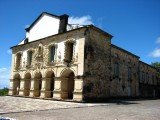Este post também está disponível em:
Português
English

In Paraíba, one of the most popular destinations besides the capital is the city of Lucena, located on the North Coast, 50 km from João Pessoa.
Lucena in Paraíba is a tropical paradise with 15 km kilometers of deserted beaches and turquoise sea, which makes Lucena, in the state of Paraíba, a paradise of perfect tranquility ideal to enjoy the vacations and excellent to live.
Colonial architecture, untouched jungle trails, lagoons and natural pools in the sea contribute to Lucena’s unique charm.
Only half an hour from the capital João Pessoa.
Only accessible by bus-boat, ferry or a quick trip through the coconut and pineapple plantations, Lucena offers the tranquility of a small and very welcoming community.
History of the city of Lucena in Paraíba
It had as its first inhabitants the Portuguese, who passed through there in 1596. The Dutch army at the time of occupation held a landing on the site and was unsuccessful.
The village served for the landing of French caravels, which trafficked brazilwood with the support of the Potiguares Indians.
Lucena was a district of Santa Rita and gained political emancipation through Law 2664, of December 22, 1961. The official installation of the municipality took place on the 29th of the same month.
Video about Lucena PB

Characteristics of the municipality of Lucena
The municipality of Lucena is composed of seven beaches. It is a city with all the infrastructure and its population, which is approximately 15 thousand inhabitants – during the four days of carnival, can reach 60 thousand people.
All its beaches are calm and intended for bathing and fishing. There are raft trips to see the fish pens that are uncovered at low tide.
There are places suitable for diving, canoeing and various water sports. In Bonsucesso, which is an extension of Praia de Lucena, you can see the ruins of the Bonsucesso Church (16th century), supported by a gameleira.
The natural beauty of the white sands is the ideal place to have a beer and eat fresh seafood. During carnival the city is crowded and animation is total.
Map of the beaches of João Pessoa and Paraíba
Main Tourist Sites of Lucena
From Cabedelo, you can reach the northern end of the coast of Paraíba, the quiet Lucena, by ferry or boat.
Along the 15 km stretch of beaches, you will find the following beaches: Costinha, Fagundes, Gameleira, Ponta de Lucena, Lucena, Camaçari and Bonsucesso.

Praia de Lucena PB
Next to the beaches of Costinha, in the estuary of the Paraíba River, Fagundes and Ponta do Lucena, coconut trees reign absolute in the landscape.
Lucena beach is still the most frequented beach in the area, almost tripling its population during festive periods such as Carnival.
This beach is also known as Praia do Holandês. It has smooth sea where sand banks appear at low tide, forming large lagoons with shallow waters at low tide.

Praia do Holandes em Lucena PB
You can visit the ruins of Bom Sucesso and the Sanctuary of Guia and delight in the rafts to observe the corrals of fish that are uncovered at low tide and delight in places for diving, canoeing, and water sports.
Buggy ride
Ruins of Bom Sucesso Church
Mirante do Bom Sucesso
Church of Nossa Senhora da Guia

The church built in the 16th century by Carmelite priests is one of the oldest in the country. Located in a preservation area where there are still remnants of the Atlantic Forest, due to its location it came to be used as an observation point against the attacks of invaders.
From the hill where it is located you can see both sea and countryside, with sugar cane plantations and coconut trees. Built in the Baroque style, its façade depicts wild plants and fruits typical of the region.
In 1763 the church was demolished and rebuilt through the efforts of Friar Manuel de Santa Teresa. From 1866 it underwent renovations and was then abandoned for several periods.
Recently it was restored according to the Project of the Cultural Foundation of the State of Paraíba. In the final stages of restoration. A unique piece of Baroque in Brazil.
Tourism and Travel Guide of Lucena in Paraíba






















